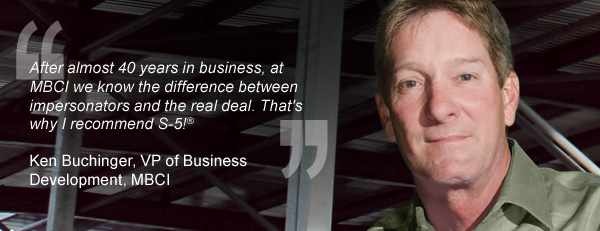No products in the cart.
[vc_row css=".vc_custom_1462375985998{margin-top: 0px !important;margin-right: 0px !important;margin-bottom: 0px !important;margin-left: 0px !important;border-top-width: 0px !important;border-right-width: 0px !important;border-bottom-width: 0px !important;border-left-width: 0px !important;}"][vc_column width="1/6" css=".vc_custom_1464724984411{margin-top: 0px !important;margin-right: 0px !important;margin-bottom: 0px !important;margin-left: 0px !important;border-top-width: 0px !important;border-right-width: 0px !important;border-bottom-width: 0px !important;border-left-width: 0px !important;padding-top: 0px !important;padding-bottom: 0px !important;}"][vc_column_text css=".vc_custom_1465480947775{margin-top: 0px !important;margin-right: 0px !important;margin-bottom: 0px !important;margin-left: 0px !important;border-top-width: 0px !important;border-right-width: 0px !important;border-bottom-width: 0px !important;border-left-width: 0px !important;}"]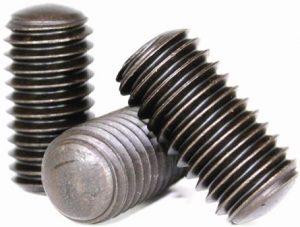 [/vc_column_text][/vc_column][vc_column width="5/6" css=".vc_custom_1464725257558{margin-top: 0px !important;margin-bottom: 0px !important;border-top-width: 0px !important;border-bottom-width: 0px !important;padding-top: 0px !important;padding-bottom: 0px !important;}"][vc_column_text]
[/vc_column_text][/vc_column][vc_column width="5/6" css=".vc_custom_1464725257558{margin-top: 0px !important;margin-bottom: 0px !important;border-top-width: 0px !important;border-bottom-width: 0px !important;padding-top: 0px !important;padding-bottom: 0px !important;}"][vc_column_text]
The REAL Truth About Setscrews
This article has been taken in its entirety from S-5!'s website and has not been edited for content. Rob Haddock is the inventor of S-5!® Clamps and is a recogonized industry expert in the field of snow retention.
By Rob Haddock[/vc_column_text][/vc_column][/vc_row][vc_row css=".vc_custom_1462375985998{margin-top: 0px !important;margin-right: 0px !important;margin-bottom: 0px !important;margin-left: 0px !important;border-top-width: 0px !important;border-right-width: 0px !important;border-bottom-width: 0px !important;border-left-width: 0px !important;}"][vc_column css=".vc_custom_1465392369261{margin-top: 0px !important;margin-right: 0px !important;margin-bottom: 0px !important;margin-left: 0px !important;border-top-width: 0px !important;border-right-width: 0px !important;border-bottom-width: 0px !important;border-left-width: 0px !important;padding-top: 0px !important;padding-bottom: 0px !important;}"][vc_column_text css=".vc_custom_1465481032061{margin-top: 1px !important;margin-right: 0px !important;margin-bottom: 0px !important;margin-left: 0px !important;border-top-width: 0px !important;border-right-width: 0px !important;border-bottom-width: 0px !important;border-left-width: 0px !important;background-color: #e6e1f2 !important;}"]
Point 1: Cup vs. Round Point Setscrews on Coated Steel
[/vc_column_text][vc_column_text css=".vc_custom_1465481829464{margin-top: 0px !important;margin-right: 0px !important;margin-bottom: 0px !important;margin-left: 0px !important;border-top-width: 0px !important;border-right-width: 0px !important;border-bottom-width: 0px !important;border-left-width: 0px !important;padding-top: 20px !important;}"]How are common cup point setscrews different than S-5! setscrews: aren’t they really about the same?
When I invented the S-5!® some 22 years ago, the first setscrew that I prototyped was a cup point setscrew. They were standard fasteners, widely available and inexpensive. But, when I observed their effects on coated steel, I knew it would never be up to S-5! standards or acceptable to the many technically informed users and manufacturers of these coated steel products. This is because a cup point setscrew is purposely made to cut into a metal surface for its holding strength. They are popular for applications where long-term corrosion issues are not a concern such as securing a pulley to a spinning shaft.
We've had competitors who don't appear to know this critical detail. Not only do their products utilize cheaper setscrews, but they actually advocate cup points as superior. Fancy product names like “posi-lok” promote the mistake, but don’t be fooled—you may be replacing roofs when they cause corrosion!
Notice the definition provided by a manufacturer of setscrews (a firm unrelated to S-5!):
Radax Industries
Cup Point Set Screws: 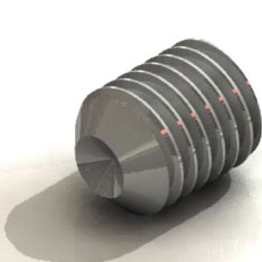
A cup point screw is the most commonly used set screw featuring a cup-shaped indentation on one end. The cup point of this screw is mainly used for a quick, semi-permanent or permanent part assembly where the cutting in of the cup point edge of the screw is acceptable.
Oval Point Set Screws:
An oval point set screw features an oval shaped point on one end. This set screw is used in an environment where frequent adjustments are needed or minimal deforming of the part is required.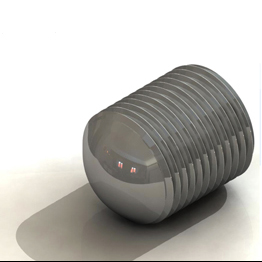
We at S-5! are not the only ones who advise against the use of cup point setscrews and support the use of round point setscrews. Here is what the following industry consensus organizations have to say:
The Metal Building Manufacturers Association (MBMA) says: “Any attendant setscrews that secure the clamp to the seam should have a rounded point (not a cup point) so that gouging, or breaching of the metallic coating is avoided.” (Metal Roofing Systems Design Manual; Second Edition; Copyright 2012; Section 7.7.1 Fasteners)
The Metal Construction Association says: “Some products utilize “cup point” set screws that may tear the seam material under load or sever and abrade panel coatings leading to premature corrosion. Others use round tipped setscrews and are preferred.” (Guidelines for Commercial Roofing; Metal Roof Design for Cold Climates; p 10)
And the United States Department of Defense (USDOD) says: “…[utilize]…continuous snow retention devices at all eaves that are non-corrosive, non-penetrating, and mechanically attached with convex setscrews to the standing seams…” (United Facilities Criteria [UFC]; Roofing; UFC-3-330-02A, 2012; Section 5-2.10.1 Snow Retention Devices)
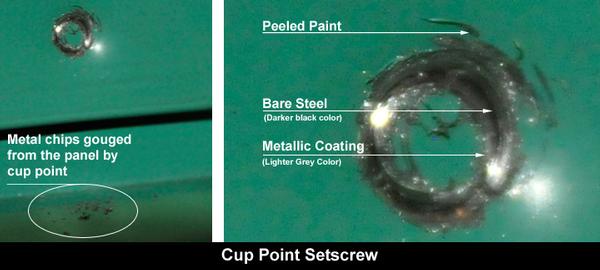 The metallic coatings that protect steel paneling from corrosion are applied in a process called “continuous hot dipping”. They are zinc and aluminum-zinc alloys, the most popular of which is trade-named Galvalume®. The application layer is very thin. ASTM A-792 standards that govern production dictate a minimum thickness of .6 mil, i.e. 6 ten-thousandths of an inch. For a sense of scale, a human hair is about 4.0 mils—almost seven times the thickness of the metallic coating. S-5! would never use any attachment that causes a breach in this protective coating because that coating is what protects the base steel from corrosion.
The metallic coatings that protect steel paneling from corrosion are applied in a process called “continuous hot dipping”. They are zinc and aluminum-zinc alloys, the most popular of which is trade-named Galvalume®. The application layer is very thin. ASTM A-792 standards that govern production dictate a minimum thickness of .6 mil, i.e. 6 ten-thousandths of an inch. For a sense of scale, a human hair is about 4.0 mils—almost seven times the thickness of the metallic coating. S-5! would never use any attachment that causes a breach in this protective coating because that coating is what protects the base steel from corrosion.The cup point digs through this thin protective coating and well beyond, into the (now) unprotected base steel, itself, creating a corrosion site. Some may argue that the gouged metal is protected from moisture, but this argument is without merit as a metal-to-metal connection is simply not moisture-proof. Additionally, when used on some materials such as pure zinc sheet, the scoring from such a setscrew can also cause a fracture point in the sheet and is prohibited from use by the producers of those materials for that reason. A polished round point setscrew was the solution to the problems presented by the cup point setscrew.
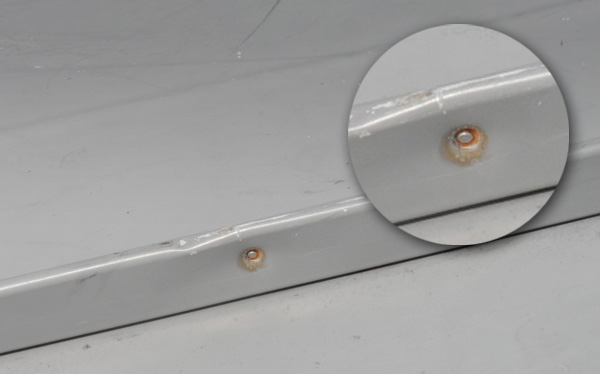 This is the result of cup-point setscrew (competitor part) after 6 years of exposure in the Northeastern U.S. The roof panels had to be replaced.
This is the result of cup-point setscrew (competitor part) after 6 years of exposure in the Northeastern U.S. The roof panels had to be replaced.The next piece of innovation to the S-5! attachment method was to force a small deformation to the panel seam material at the setscrew location, creating a mechanical lock to increase the attachment’s holding strength. This was accomplished via a small cavity in the clamp wall on the opposite side of the seam from the setscrew. I got this idea from a process called “button punching”. This was a common way to secure a standing seam back in the ‘40’s, 50’s and 60’s. The button punch was a large plier that had mating jaws with a concave and convex die respectively. I designed the S-5! attachment to create the same sort of “dimple” by using a round point screw and a cavity in the clamp wall. This design, utilizing the above-described technologies, was patented by me in 1992-94 and was followed by numerous other S-5! patents (there are over 20 U.S. and foreign patents in the S-5! portfolio).
 S-5-E; Butler MR24 machine folded trapezoidal standing seam; 24-gauge unpainted Galvalume® steel; screw tension: 140 in-lbs. Most low-slope standing seams utilize similar profiles. Notice that the coating at the top of the seam has been "micro-crazed" by the Butler seaming machine, but not by the setscrew dimples. The round point of the setscrew has "polished" the finish of the Galvalume coating, but not broken it. On the backside, the dimples are barely even visible and the "spangle" of the Galvalume finish is undisturbed
S-5-E; Butler MR24 machine folded trapezoidal standing seam; 24-gauge unpainted Galvalume® steel; screw tension: 140 in-lbs. Most low-slope standing seams utilize similar profiles. Notice that the coating at the top of the seam has been "micro-crazed" by the Butler seaming machine, but not by the setscrew dimples. The round point of the setscrew has "polished" the finish of the Galvalume coating, but not broken it. On the backside, the dimples are barely even visible and the "spangle" of the Galvalume finish is undisturbedBecause the issue of “doing the roof no harm” was so vital to us at S-5!, we also commissioned independent, third-party A2LA certified test labs to conduct accelerated corrosion and weathering tests to prove that the S-5! attachment method caused no premature corrosion of the panel material. But lab tests do not always tell the whole truth about what happens in actual exposure over time. So, the real test is exposure on real roofs in many different environments over many years of time.
In the end, the evidence is 22 years of successful installations on more than 1.5 million roofs, and endorsement by every major manufacturer of metal roofing not only in North America, but also the entire world without a single report of corrosion issues- ever! S-5! clamps have even been selected for use in life-safety applications on the new NATO World Headquarters in Brussels, Belgium, and are endorsed by the inventor of Galvalume® himself!
[/vc_column_text][/vc_column][/vc_row][vc_row css=".vc_custom_1462375985998{margin-top: 0px !important;margin-right: 0px !important;margin-bottom: 0px !important;margin-left: 0px !important;border-top-width: 0px !important;border-right-width: 0px !important;border-bottom-width: 0px !important;border-left-width: 0px !important;}"][vc_column css=".vc_custom_1465480197992{margin-top: 0px !important;margin-right: 0px !important;margin-bottom: 0px !important;margin-left: 0px !important;border-top-width: 0px !important;border-right-width: 0px !important;border-bottom-width: 0px !important;border-left-width: 0px !important;padding-top: 0px !important;padding-bottom: 0px !important;}"][vc_column_text css=".vc_custom_1465481419223{margin-top: 1px !important;margin-right: 0px !important;margin-bottom: 0px !important;margin-left: 0px !important;border-top-width: 0px !important;border-right-width: 0px !important;border-bottom-width: 0px !important;border-left-width: 0px !important;background-color: #e6e1f2 !important;}"]
Point 2: Paint Issues
[/vc_column_text][vc_row_inner][vc_column_inner css=".vc_custom_1465392439823{padding-top: 20px !important;}"][vc_column_text]Do S-5! round point setscrews and related hardware damage paint on metal panels? If so, how is that different than the fact that cup point setscrews cut through paint and metallic finishes?
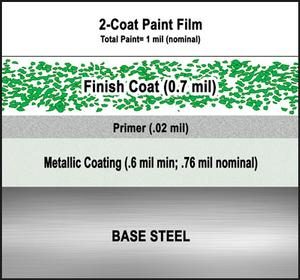 It is important to know the function of paint when used on metal panels; specifically the popular Kynar/Hylar PVDF resins commonly used within our industry. The industry uses almost exclusively what are referred to as “thin film” paints. They are composed of a prime coat and finish coat. These films are .2 mil and .7 mil respectively, for a total (minimum) dry film thickness of .9 mil. Thin film paints have porosity—that is to say they are moisture permeable. The paint takes on and releases moisture cyclically when there is rain or snow present. If you are observant you can see this effect because the color of the paint film darkens slightly when it is wet. You see, that is why the metallic coating beneath the paint is still vital for corrosion protection—the metal substrate still gets wet through the paint. It is a common misperception that these paint types provide corrosion protection.
It is important to know the function of paint when used on metal panels; specifically the popular Kynar/Hylar PVDF resins commonly used within our industry. The industry uses almost exclusively what are referred to as “thin film” paints. They are composed of a prime coat and finish coat. These films are .2 mil and .7 mil respectively, for a total (minimum) dry film thickness of .9 mil. Thin film paints have porosity—that is to say they are moisture permeable. The paint takes on and releases moisture cyclically when there is rain or snow present. If you are observant you can see this effect because the color of the paint film darkens slightly when it is wet. You see, that is why the metallic coating beneath the paint is still vital for corrosion protection—the metal substrate still gets wet through the paint. It is a common misperception that these paint types provide corrosion protection.
Rather, paint on metal panels is primarily cosmetic—to give them the range of colors that we individually find more attractive than a bare, metallic surface. All the above is not necessarily true in other industries. The automotive industry for instance, is quite another story and may use very thick films and different paint chemistries altogether to provide corrosion protection—not the same thing.
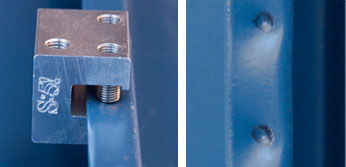 S-5-U; MBCI BattenLok; 22-gauge Galvalume; Kynar 500 paint; screw tension: 175 in-lbs. This is the old "Armco" style seam. The light dots in the center of the dimples are not breaches of the paint, but light reflection. The dark areas are metal oxide deposits from the setscrews.
S-5-U; MBCI BattenLok; 22-gauge Galvalume; Kynar 500 paint; screw tension: 175 in-lbs. This is the old "Armco" style seam. The light dots in the center of the dimples are not breaches of the paint, but light reflection. The dark areas are metal oxide deposits from the setscrews.
Think of this painted panel as your fingertip. The Galvalume® metallic coating is as the fingernail that protects the sensitive flesh and nerves below (the carbon steel sheet). Now if you (or your wife) paint your fingernail, it is primarily a cosmetic treatment to give it color—just like thin film paint on a metal panel. If the paint abrades or scratches on that nail, it does not hurt your flesh under the nail, because the real protection was the nail, not the paint. But if you puncture or break the nail it is very painful to the flesh and nerves below. When the metallic coating is breached, it is likewise painful in terms of corrosive effects that can shorten the life of the base steel sheet.
 S-5-E; traditional double folded standing seam; 28-gauge Terne II (by Follansbee Steel); pre-painted Kynar 500; screw tension: 140 in-lbs. The darkened areas within the setscrew dimples are the result of metal oxides impinged on the paint surface by the setscrew point, NOT a breach of the paint or metallic coating. The light abrasions at the top of the seam and lower left dimple are minor loss of the finish coat, exposing the paint primer but not metallic coating or base steel
S-5-E; traditional double folded standing seam; 28-gauge Terne II (by Follansbee Steel); pre-painted Kynar 500; screw tension: 140 in-lbs. The darkened areas within the setscrew dimples are the result of metal oxides impinged on the paint surface by the setscrew point, NOT a breach of the paint or metallic coating. The light abrasions at the top of the seam and lower left dimple are minor loss of the finish coat, exposing the paint primer but not metallic coating or base steel
Paint films for metal panel finishes are governed by a host of ASTM specifications with respect to their performance, including Flexibility (D-4145). Paint is ductile—it must be to endure the bending and forming that occurs during panel profiling and machine seaming. It will respond well to the slight “dimpling” of the panel that is intended by our setscrew. Paint film adhesion is also tested (by most) by ASTM D-3359. When paint films meet these industry standards our setscrews may on occasion impinge the film slightly, if at all. When the film integrity does not meet minimum industry standards, our setscrew may cause some slight abrasion to the paint, but never to the metallic coating below. Contrarily, cup point setscrews dig through it all—paint and metallic coating—straight through to the corrosive base steel.
 S-5-S; typical "snap seam" profile (this one by AEP); 24-gauge Galvalume; Kynar 500 paint; screw tension: 140 in-lbs. The darkened areas are a combination of shadow and metal oxide deposits on the surface of the paint.
S-5-S; typical "snap seam" profile (this one by AEP); 24-gauge Galvalume; Kynar 500 paint; screw tension: 140 in-lbs. The darkened areas are a combination of shadow and metal oxide deposits on the surface of the paint.
In some instances, it may look as though a round point setscrew has scratched a panel seam down to the metal. However, the lighter color is the paint primer, which is usually off-white, yellowish or yellow-green in color. Even if the round point setscrew were to expose the metallic coating, the coating itself will never be breached as it is with cup point setscrews.
 S-5-E; traditional double folded standing seam; 26-gauge Galvalume steel; screw tension: 140 in-lbs; Kynar 500 paint. The slight abrasions on the seam and at the top of the backside dimple is exposure of the paint primer. The paint on this specimen would not pass ASTM D-3359 for film adhesion. Nevertheless, no harm is done from a weathering standpoint, as the metallic coating is never breached.
S-5-E; traditional double folded standing seam; 26-gauge Galvalume steel; screw tension: 140 in-lbs; Kynar 500 paint. The slight abrasions on the seam and at the top of the backside dimple is exposure of the paint primer. The paint on this specimen would not pass ASTM D-3359 for film adhesion. Nevertheless, no harm is done from a weathering standpoint, as the metallic coating is never breached.
[/vc_column_text][/vc_column_inner][/vc_row_inner][/vc_column][/vc_row][vc_row css=".vc_custom_1462375985998{margin-top: 0px !important;margin-right: 0px !important;margin-bottom: 0px !important;margin-left: 0px !important;border-top-width: 0px !important;border-right-width: 0px !important;border-bottom-width: 0px !important;border-left-width: 0px !important;}"][vc_column css=".vc_custom_1465480197992{margin-top: 0px !important;margin-right: 0px !important;margin-bottom: 0px !important;margin-left: 0px !important;border-top-width: 0px !important;border-right-width: 0px !important;border-bottom-width: 0px !important;border-left-width: 0px !important;padding-top: 0px !important;padding-bottom: 0px !important;}"][vc_column_text css=".vc_custom_1465481597795{margin-top: 1px !important;margin-right: 0px !important;margin-bottom: 0px !important;margin-left: 0px !important;border-top-width: 0px !important;border-right-width: 0px !important;border-bottom-width: 0px !important;border-left-width: 0px !important;background-color: #e6e1f2 !important;}"]
Point 3: Holding Strength
[/vc_column_text][vc_row_inner][vc_column_inner css=".vc_custom_1465392439823{padding-top: 20px !important;}"][vc_column_text]Why does S-5! have all those “load tables” on the website?
In order for appropriate applications engineering to be applied in a meaningful way, there was a need to quantify this new and unique S-5! attachment method prior to a successful product launch. It was not enough to say, “It’s really strong”; but users need to know, how strong is “strong.” For that reason, we drafted a specific test protocol (none existed within ASTM), and have done thousands of tensile-load tests to prove the holding strength of S-5! clamps on dozens of seam geometries and materials. I’m quite sure that we have done more testing than all competitors globally combined. We publish the results of those tests on tables at our website for all to see and use http://www.s-5.com/clamps. Holding strengths vary with each material type and gauge thickness as the table will indicate. All this testing was also conducted in third-party A2LA accredited laboratories. Don’t assume that some competitive part will achieve the same holding strength—they will not.
Our average ultimate failure load on our 2-screw clamp is in the range of 1600-2,400 pounds — three times that of our closest competitor's clamp. In fact, our competitors typically only test on one steel gauge and publish the raw results without a safety factor.
At S-5!, however, we test our clamps with a wide variety of gauges, materials and profiles. We also suggest a factor of safety not less than 2.0. We use this (higher) factor of safety not because we don’t trust our tests or parts, but because the entire U.S. engineering community agrees that anything below 2.0 is not adequate for any mechanical interlock fastening of this nature.
The setscrew tension we chose for testing was 115 inch-pounds. This is because all industrial grade electric guns are rated to at least that driving torque. They will typically deliver significantly more, but are rated at that minimum. We publish and instruct an installation tolerance of 130-150 inch pounds. This is to ensure that the minimum tested tension is in fact reached, and to allow the installer a reasonable window of installation tolerance and margin of error, without jeopardizing published load capacity. 22-gauge steel (which is rarely used) increases the tested and tension to 150 inch-pounds and recommended 160-180 for installation.
Engineers, code authorities and installation consultants universally agree that this the appropriate practice. And by the way, in case you didn’t know this about S-5! clamps, it is not necessary to torque-check setscrews unless the installation is critical to reliance upon published load-to-failure values. Even then, you typically would check one out of a hundred or so, just to be sure your gun is still delivering the required tension. The S-5! line of clamps will still provide significant holding strength at less than optimal screw tension.
[/vc_column_text][/vc_column_inner][/vc_row_inner][/vc_column][/vc_row][vc_row css=".vc_custom_1462375985998{margin-top: 0px !important;margin-right: 0px !important;margin-bottom: 0px !important;margin-left: 0px !important;border-top-width: 0px !important;border-right-width: 0px !important;border-bottom-width: 0px !important;border-left-width: 0px !important;}"][vc_column css=".vc_custom_1465480197992{margin-top: 0px !important;margin-right: 0px !important;margin-bottom: 0px !important;margin-left: 0px !important;border-top-width: 0px !important;border-right-width: 0px !important;border-bottom-width: 0px !important;border-left-width: 0px !important;padding-top: 0px !important;padding-bottom: 0px !important;}"][vc_column_text css=".vc_custom_1465481662092{margin-top: 1px !important;margin-right: 0px !important;margin-bottom: 0px !important;margin-left: 0px !important;border-top-width: 0px !important;border-right-width: 0px !important;border-bottom-width: 0px !important;border-left-width: 0px !important;background-color: #e6e1f2 !important;}"]
Conclusion
[/vc_column_text][vc_row_inner][vc_column_inner css=".vc_custom_1465392439823{padding-top: 20px !important;}"][vc_column_text]Thank you for taking the time to read the facts about setscrews, and the explanation of why we chose the setscrews that enable S-5! clamps to be the strongest and most widely endorsed on the market today.
Please be assured that at S-5! we will continue to do it the right way.

Rob Haddock - CEO[/vc_column_text][/vc_column_inner][/vc_row_inner][/vc_column][/vc_row]

